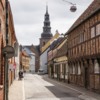"This is Ystad," announced the conductor on the train that had brought me to this southernmost part of Sweden. It was a low-key announcement that didn't do justice to this stunningly beautiful town overlooking the Baltic Sea.
I had travelled from Stockholm on two trains to get here, eager to see this former Danish territory and thriving film production hub. Visitors to the town can learn all about this local "Hollywood" at Ystad Studios Visitor Center in Elis Nilsson's Road.
I stayed at the charming old-world hotel, Continental Du Sud, which claims to be Sweden's oldest hotel and is just a two-minute walk from the railway station. I paid $US360 for two nights including a generous buffet breakfast.
The Wallander factor
Ystad (pronounced ee´ stahd) is the setting for the Kurt Wallander TV series about a fictional Swedish police detective created by author Henning Mankell. Wallander books have sold 30 million copies worldwide and been translated into 43 languages. About 20 per cent of tourists come to Ystad just because of Wallander.
Wallander guided tours run in the summer, or you can take a self-guided walking tour any time, to see some of the locations used in the filming. The old town hall facade, Gamla Rådhuset, became a bank in one episode, and a building at Mariagatan doubled as Wallander's apartment. On Sjömansgatan overlooking the harbour is the Ystad Theatre (below), where a car bomb explodes in the episode entitled The Cellist.
Danish influence
But enough about Wallander, Ystad, with a population of around 29,000, has more than enough attractions in its own right. In terms of its architecture Ystad is unlike most of Sweden because, in its early years, it belonged to Denmark along with the rest of Skåne, the province in which it's located. In 1658 the Treaty of Roskilde ended centuries of Danish rule and Skåne was ceded to Sweden.
The early Danish influence, combined with Swedish development, has produced a hybrid town full of delightful half-timbered houses. There are literally hundreds of these striking buildings dating back to at least the 15th century. Everywhere are reminders of medieval times, yet the streets also buzz with contemporary shops, cafés, bars and restaurants – many of them incorporated into the old buildings – as well as museums and art galleries. The result is a stunning small town that is a pleasure to wander around.
Ferry services
Ystad can also be used as a jumping off point for more adventurous travel in other parts of the Baltic region. Take one of the regular ferry services to Swinoujscie in Poland and from there strike out to Lithuania, Estonia and Latvia.
Getting there
Ystad can be reached from Stockholm by high-speed train, changing at Lund or Malmö to a regional train. The entire journey takes about 5½ hours. From Copenhagen it's even closer. A train ride, which crosses the magnificent Øresund Bridge (the subject of yet another Scandinavian TV series, The Bridge) takes 1½ hours. I travelled around Scandinavia on a Eurail Pass, sold online and available only to travellers who live outside Europe. A first-class pass allowing travel on any eight days within two months and valid for Denmark, Norway, Sweden and Finland costs US$487. It is also good for travel on some ferry services.
visitsweden.com/where-to-go/southern-sweden/skane/wallanders-ystad
Note: This trip took place before COVID. Sweden’s borders are currently closed to non-essential travellers from outside the EU


Comments (0)